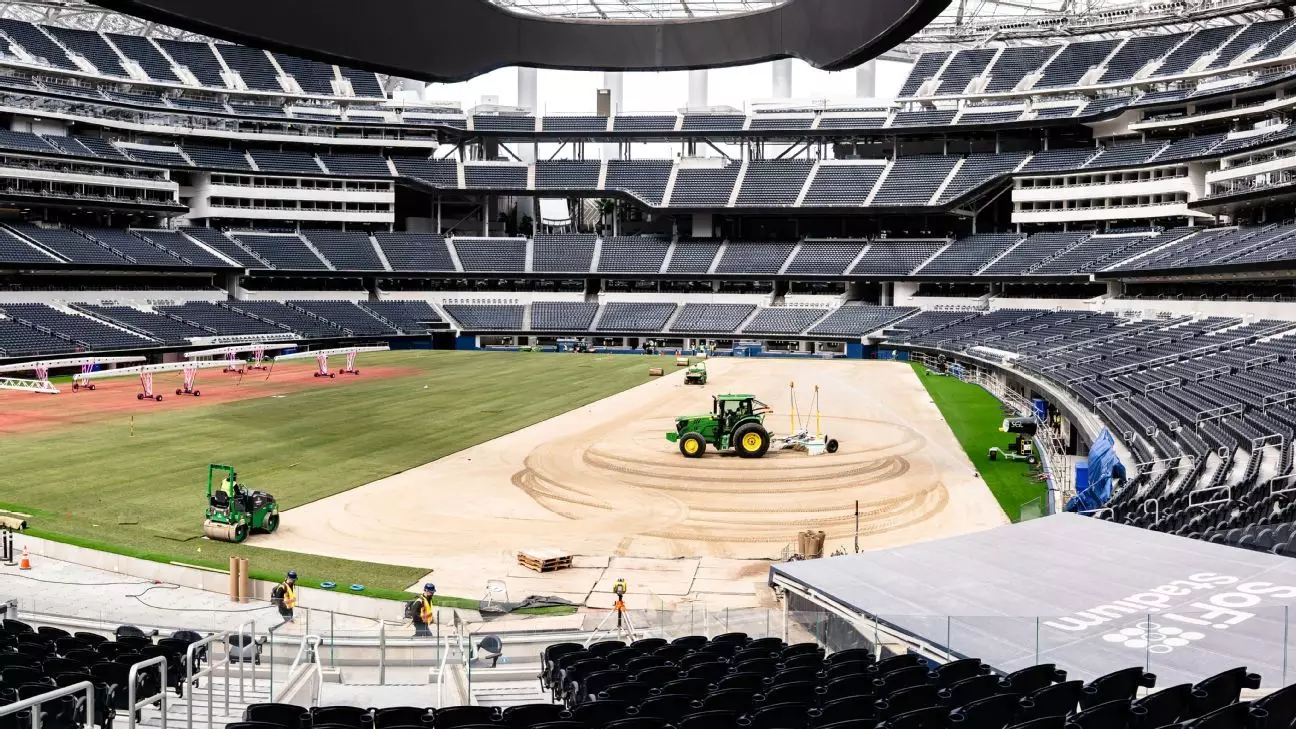SoFi Stadium, an architectural marvel in Los Angeles, is poised to make history with its innovative installation of hybrid grass technology—an initiative designed not only to enhance player performance but also to set a new standard for the forthcoming World Cup in 2026. As the stadium prepares to host crucial matches in the Concacaf Nations League, it finds itself at the intersection of sports and cutting-edge technology, making it a pivotal player in the evolution of how soccer is experienced in America.
This hybrid grass field combines artificial turf with natural grass, engineered to withstand the rigors of high-stakes competitions. Otto Benedict, the stadium’s senior vice president of facilities, articulated the importance of this experiment: “This is really a great opportunity for us to put together and test and learn.” It’s clear that the objective isn’t merely to host matches but to revolutionize them, ultimately crafting an unforgettable experience for players and fans alike.
The Science Behind the Innovation
The hybrid grass system embodies layers of advanced design principles. At its core lies a “permavoid” grow system—a remarkable setup that permits air circulation beneath the grass roots, ensuring that the turf remains healthy and vibrant. Benedict explained that this dual nature of the field minimizes the risk of damage, with grass growing interlaced with artificial fibers, providing a unique stability that traditional pitches lack.
What’s particularly fascinating is the introduction of air-drying technology that allows stadium officials to manage moisture levels actively. This level of control stands in stark contrast to last year’s Copa América, where players complained about varying grass conditions across stadiums. The potential for adaptability is present, enabling teams to play under optimal conditions regardless of external factors like weather.
A Testament to Player Experience and Aesthetics
The synthetic and organic blend creates a visually appealing surface that looks and feels like natural grass, a point echoed by former U.S. men’s national team member Cobi Jones, who admitted, “It just looks like grass to me.” This blurring of lines between synthetic and natural surfaces suggests that the future of sports fields may prioritize aesthetics alongside functionality.
Players like Weston McKennie have publicly criticized traditional grass fields for their patchy and uneven surfaces. The innovative approach taken by SoFi Stadium could very well address these prevalent issues, enhancing athletes’ on-field experience and performance. The commitment to a well-maintained grass field isn’t just a logistical improvement; it reflects a philosophical shift towards prioritizing player welfare.
Managing the Unique Challenges of Indoor Turf
Another notable aspect of SoFi Stadium’s hybrid flooring is its ability to thrive in unique conditions. Shielded from natural sunlight under the stadium’s elaborate roof structure, the grass thrives under the care of LED grow lights that mimic the sun’s nurturing rays. While one might assume that traditional sunlight is essential for grass growth, the advanced grow lights enable continuous monitoring of health and performance, exploring how these artificial conditions can compare to their natural counterparts.
Moreover, SoFi is proactively growing additional hybrid grass in the stadium’s parking lot, allowing for quick replacements of any worn sections during match play. This level of foresight adds another layer to the stadium’s operation, signaling a holistic commitment to excellence.
Challenges Ahead: Maintenance and Continual Innovation
Maintaining this hybrid system is no small feat, requiring a dedicated staff of over 30 individuals—nearly double what is needed for conventional artificial fields. The complexity of this maintenance reflects the careful balancing act involved in ensuring that the pitch remains competitive and player-friendly.
As this unique system is put to the test via multiple matches and events, stadium officials are continually learning and adapting their strategies. Following the FIFA Women’s National Team’s highly anticipated match against Brazil, the hybrid system will be disassembled. Yet, the knowledge gained from this innovative endeavor is destined to inform future improvements, potentially influencing the design of soccer venues worldwide.
This continual pursuit of excellence exemplifies how SoFi Stadium is not just a hosting venue but a high-tech laboratory for future sports innovations. The outcomes of these experimental upgrades could pave the way for a renaissance in field technology, marking a significant milestone for soccer in the United States as the 2026 World Cup approaches.

